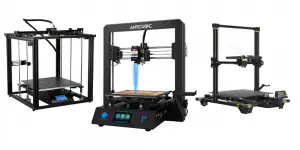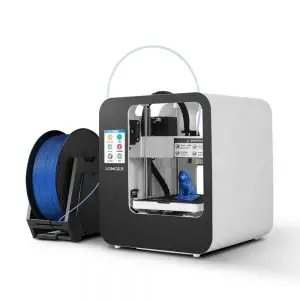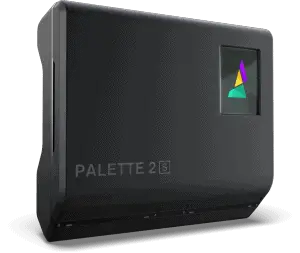If You’re In A Hurry And Just Want To Know What The Best Direct Drive 3D Printer, Then We Recommend Artillery Sidewinder X1 As The Best One.
While you may be familiar with the 3D printing process, some features and their importance can be overlooked at times. Having a direct drive 3D printer can enhance your 3D printing experience, but with so many options, it can be hard to narrow down the choices. Let’s identify some of the key things to look for in a direct drive 3D printer.





Things to Consider
3D printer direct drive, hot end, direct extruder, dual extruder … all of these terms can throw anyone off when shopping for the best direct drive extruder 3D printer. Figuring out the 3D printer direct drive feature should be one of the first things to look for when scouring the technical specifications of any printer. Let’s examine some common questions that arise when looking for a printer with a direct-drive extruder or dual extruder.
What is an Extruder?
A 3D printer using filament as its building materials must come equipped with an extruder. You’ll notice it as a single component made up of the hot end and the cold end.
What is the Cold End?
The cold end handles the filament prior to its extrusion through the hot end and onto the print bed. It’s made up of a motor and gears that when located directly above the hot end is considered a direct-drive extruder.
What Happens in the Cold End?
The stepper motor and toothed gear work alongside a hobbed gear that pulls the filaments from its roll and feeds it directly into the hot end.
What is the Hot End?
Once the filament is passed through the cold end, it’s heated to create prints onto the build plate. The average hot end is a nozzle measuring 0.40 mm in diameter. Different sized hot ends can be swapped if the machine is mod-friendly to better suit flexible filaments that may need a nozzle with a diameter of 0.30 mm or 0.50 mm.
What Happens in the Hot End?
A sequence of processes that manage the heat break and heat sink ensure the filament is melted into a liquid form with the right viscosity and at the best pace for the building materials and designs to be constructed. The melted filament is pushed onto the print bed layer by layer until the entire build is complete.
Direct Drive Extruders
You’ll be able to pinpoint the direct extruder because the extruder’s motor and gears are placed directly above the hot end. Some of the best direct drive extruder 3D printers have filament feeding directly into the hot end without any additional PTFE tubing to guide it as it comes off the roll.
Direct Drive Pros & Cons
Pros
- Accurate extrusion doesn’t leave room for error or tangling
- Faster retraction reduces the possibility of clogging since the extruder’s close to the nozzle
- Energy-efficient motors don’t require as much torque to pull the filament so it requires less energy
- Building materials of varying properties can be used
Cons
- The motor adds weight to the hot end which puts pressure on the nozzle restricting its range of motion and limiting its steadiness
- Slower print speeds are necessary to adjust for the extra weight and movement
The Best Direct Drive Printers
Here are five choices to consider when in the market for a direct drive 3d printer.
FlashForge Creator Pro
This enclosed 3D printer uses standard and exotic filaments really well due to its ability to maintain a steady temperature consistently. It’s built solid and sturdy and remains a contender for the best dual extruder 3D printer. Technical support is available should users run into any issues and there’s a manufacturer’s warranty upon purchase.
FlashForge Creator Pro Technical Specs:
- Extruder: Dual Direct Drive
- Build Volume: 227 mm x 148 mm x 150 mm (8.9 in x 5.8 in x 5.9 in)
- Build Materials: PLA, ABS, HIPS, PETG, TPE, TPU, Conductive filament, flexible, metal, and wood.
- Print Bed: Manual leveling, heated, non-removable
Pros
- Sturdy assembly
- Works right out of the box
- Dual direct-drive extruder
- Large, enclosed build area
- Compatible with multiple filament types
Cons
- Manual leveling of the aluminum print bed that can’t be removed
- Dual head exertion and clogging have been reported leaving some users to only use one extruder
- SD card slot is inside the enclosure
Monoprice Maker Select Plus
The Monoprice Maker Select Plus is priced modestly for all of the benefits that come included with the machine. There’s an easy-to-use touchscreen to navigate the menu with a decent sized and open build area. Technical support is available through live chat on the company’s website along with email and phone support.
Monoprice Maker Select Plus Technical Specs:
- Extruder: Single Direct Drive
- Build Volume: 200 mm x 200 mm x 180 mm (7.9 in x 7.9 in x 7.1 in)
- Build Materials: PLA, ABS, Conductible PLA, Wood, Metal, and Dissolving PLA
- Print Bed: Manual leveling, heated, aluminum, non-removable
Pros
- Impressive build speed of 70 mm per second
- Easy-to-use touchscreen
- Anti-jam MK10 extruder
- Comes mostly assembled
- Open-source and commercial slicer software is compatible
Cons
- Can’t remove the print bed
- The open area doesn’t provide consistent heat settings for ABS
Sovol SV01
The Sovol SV01 comes mostly assembled and is decently priced at a rate that makes it worthy of consideration. It comes with lifetime technical support while featuring some great options like filament runout detection and a resume printing feature should the printer stop printing and have to resume at a later time.
Sovol SV01 Technical Specs:
- Extruder: Single Direct Drive
- Build Volume: 280 mm x 240 mm x 300 mm (11.02 in x 9.45 in x 11.81 in)
- Build Materials: PLA, ABS, PETG, TPU
- Print Bed: Manual leveling, heated, glass, non-removable
Pros
- Large build area
- Manual leveling can be upgraded to BL-Touch auto-leveling
- 3rd party filaments can be used
- Sturdy frame
- It can be used tethered or untethered to a computer
Cons
- The hot end doesn’t heat beyond 250℃ which limits printing with ABS
- Manual leveling and a non-removable print bed can make use cumbersome
- Users report clogging issues
Artillery Sidewinder X1
The newest model of the Artillery Sidewinder X1 is an ultra-quiet printer that comes 95% assembled. It features a sturdy frame, filament runout detection, and a massive build area. It heats up fast, prints fast, and is easy to use.
Artillery Sidewinder X1 Technical Specs:
- Extruder: Single Direct Drive
- Build Volume: 300 mm x 300 mm x 400 mm (11.81 in x 11.81 in x 15.75 in)
- Build Materials: PLA, ABS, HIPS, TPU, Wood, and flexible materials
- Print Bed: Manual leveling, heated, glass
Pros
- The touchscreen is easy to use
- It prints quietly
- Large build area
- It prints fast (10-80 mm per second)
- Easy to assemble as most of it is done for you
Cons
- The menu can be clumsy at times with a micro-SD card
- The glass bed can’t maintain consistent temps if the heat is shut off should the filament run out or the power gets cut
- Open build area can be problematic when printing ABS
Qidi Tech X-Pro
The Qidi Tech X-Pro 3D printer is in the higher price range, but some of the features make it worth considering its luxury price tag. The company offers an exclusive and fast technical support team that promises to respond to inquiries within 24 hours. It also boasts several upgrades that include a new stepper motor, mainboard, and structure to enforce stable printing.
Qidi Tech X-Pro Technical Specs:
- Extruder: Dual Direct Drive
- Build Volume: 230 mm x 150 mm x 150 mm ( 9.1 in x 5.9 in x 5.9 in)
- Build Materials: PLA, ABS, TPU, HIPS, PETG
- Print Bed: Manual leveling, heated, removable
Pros
- Prints great with exotic and flexible filaments
- Removable build plate
- Dual extruders for 2-color print jobs
- Great customer service
- Easy to set up and to use
Cons
- 3-point leveling instead of 4 can cause issues when prepping for a build
- Builds can have some adhesion issues with the bed
- Guide documentation can use clarification
What’s the Verdict?
Direct drive is better for flexible filament support. Make sure the entire frame is solid for the 3D printer you decide to buy. You’ll more than likely have to run your prints at slower speeds to adjust for the motor having to run along the x-carriage which adds weight that can shake the build unnecessarily.
Between the FlashForge Creator Pro and the Qidi Tech X-Pro as the best dual extruder 3D printer, the Qidi Tech X-Pro outshines the FlashForge simply because the print bed can be removed. Prying a print off the build plate can be difficult on any bed that can’t be removed from the print base, but with a bed inside of an enclosure, there’s literally no wiggle room. When it comes to best direct drive extruder 3D printer, for its price, massive build volume, and its compatibility with a large number of build materials, the Artillery Sidewinder X1 dwarfs the competition.
If choosing between the Qidi Tech X-Pro and the Artillery Sidewinder X1, the Sidewinder comes out on top across the board because of its price and size. The ability to create large-scaled builds opens up the possibilities for many creative ideas to flourish.
Last update on 2025-05-30 / Affiliate links / Images from Amazon Product Advertising API









